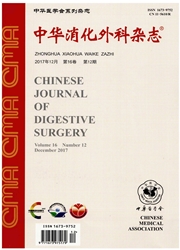

 中文摘要:
中文摘要:
目的:研究CT对胰腺癌胰外神经侵犯的诊断价值。方法:32例外科手术和病理证实的胰腺癌,术前1个月内均行螺旋CT检查。回顾性分析肿瘤大小、胰周血管侵犯、淋巴结转移和胰外神经侵犯情况,根据胰周腹腔神经丛主干及腹腔神经节周围软组织改变确定胰外神经侵犯的CT征象。以病理结果为标准,分析CT对胰外神经侵犯的准确性、特异性和敏感性,以及胰外神经侵犯与肿瘤大小、胰周血管侵犯、淋巴结转移的相关性。结果:32例胰腺癌,病理发现胰内和(或)胰周神经侵犯27例(84.4%),胰内合并胰周神经侵犯24例(75%),单纯胰内神经侵犯3例(9.4%)。CT发现22例(68.8%)胰外神经侵犯,CT诊断胰腺癌胰外神经侵犯的敏感性、特异性、准确性分别为87.0%、77.8%、84.4%。胰外神经侵犯与肿瘤大小(Spearman,P=0.428〉0.05)、淋巴结转移(Fisher’s exacttest,P=0.506〉0.05)无相关性,与血管侵犯(Spearman,r=0.54,P=0.001〈0.05)具有相关性。结论:CT对胰腺癌胰外神经侵犯有较高的预测率。胰周间隙密度增高,出现条带状致密影,或出现不规则软组织块影提示已有肿瘤的神经侵犯。
 英文摘要:
英文摘要:
Purpose: To study the value of CT in diagnosis of extrapancreatic neural plexus invasion by pancreatic carcinoma. Methods: Thirty two patients with pancreatic carcinomas confirmed by surgery and pathology were performed CT imaging within one month before surgery. Two radiologists independently reviewed the CT images to observe the diameter of the tumor, the peripancreas vascular invasion, lymph adenopathy and extrapancreatic neural plexus invasion. The extrapancreatic neural plexus invasion on CT images was defined as soft tissue in the main routes of both the nerves from the celiacplexus and ganglia to the pancreas. The CT findings were compared with that of pathology, the accuracy, specificity, sensitivity for CT diagnosing extrapancreatic neural plexus invasion were calculated, and the relation between extrapancreatic neural plexus invasion and other CT findings were evaluated. Results: In the 32 patients with pancreatic carcinoma, the neural plexus invasion by the tumor on pathology was 84.4%, 75% and 9.4% for intra- and/or extra- pancreatic, both intra- and extra-pancreatic, and only intrapancreatic neural plexus invasion. Twenty - two patients(68.8% )were shown extrapancreatic neural plexus invasion on CT images, which including streaky in peripancreas fat space or vascular space and soft mass near the tumor or peripancreas vascular space. The sensitivity, specificity and accuracy for CT diagnosing extrapancreatic neural plexus invasion by pancreatic carcinoma was 87%, 77.8% and 84.4% respectively. The extrapancreatic neural plexus invasion by pancreatic carcinoma on CT images was related to vascular invasion(Spearman, r = 0.54, P = 0.001 〈 0.05), but was not correlated with the diameter of the tumor (Spearman, P = 0. 428 〉 0.05) and lymph adenopathy(Fisher' s exact test, P = 0. 506 〉 0.05). Conclusion:CT is useful to depict extrapancreatic neural plexus invasion by pancreatic carcinoma.
 同期刊论文项目
同期刊论文项目
 同项目期刊论文
同项目期刊论文
 期刊信息
期刊信息
